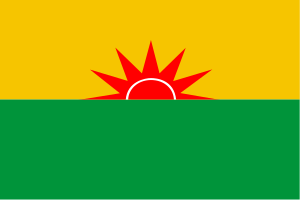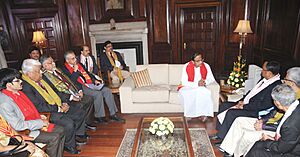United Liberation Front of Asom facts for kids
Quick facts for kids United Liberation Front of Assam |
|
|---|---|
| Participant in Insurgency in Northeast India | |
 |
|
| Active | 7 April 1979 – 29 December 2023(44 years)[Ulfa-pro truce faction] 7 April 1979 – present (46 years) [Ulfa-I] |
| Ideology | Assamese nationalism Socialism |
| Motives | Establishment of an independent Assam |
| Allegiance | United National Liberation Front of Western South East Asia |
| Groups | Political Wing Sanjukta Mukti Fouj (Armed Wing) |
| Leaders | Paresh Baruah, Arabinda Rajkhowa, Pradip Gogoi, Anup Chetia, Raju Baruah, Sashadhar Choudhury, Chitraban Hazarika, Mithinga Daimary, Bolin Das, Pranati Deka |
| Headquarters | Myanmar and China |
| Area of operations | Assam, India |
| Split to | United Liberation Front of Asom – Independent (ULFA-I) United Liberation Front of Asom (Pro-truce faction) |
| Opponents | Government of India, Government of Assam |
| Battles and wars | Insurgency in Northeast India |
| Designated as a terrorist organisation by | |
The United Liberation Front of Assam (ULFA) is a group that used to fight for an independent state in Assam, Northeast India. They wanted Assam to be a separate country for the Assamese people. The Government of India banned ULFA in 1990. They called it a terrorist group.
ULFA was started on April 7, 1979. It began its actions in 1990. The group formed connections with other groups like the Nationalist Socialist Council of Nagaland and the Kachin Independent Army in Myanmar. The Indian Army started operations against ULFA in 1990. In 2011, a big effort in Bangladesh helped the Indian government bring ULFA leaders to talks. ULFA later changed its mind and stopped demanding full independence for talks with the government.
On September 3, 2011, ULFA signed an agreement to stop fighting. This agreement was made with the Indian government and the Assam government.
How ULFA Started
ULFA was formed on April 7, 1979, in Sivasagar, Assam. A group of young men started it. These included Paresh Baruah, Arabinda Rajkhowa, and Anup Chetia. Their main goal was to create a separate, independent state of Assam through armed struggle.
In the late 1980s and 1990s, many Assamese people supported ULFA. They felt a strong group was needed to make their voices heard in Delhi. However, ULFA also started using methods like demanding money and smuggling weapons. This led to violence across Assam. Many innocent people were hurt or killed during this time. It is thought that over 10,000 young people died. Because of army actions and less public support, ULFA's influence in Assam became much smaller.
ULFA began recruiting members in 1983. By 1984, they sought training and weapons from groups like the Kachin Independence Army (KIA). In 1986, they started collecting money through demands across India. The government declared ULFA a terrorist group on November 7, 1990.
In its first ten years, ULFA became a powerful group in Southeast Asia. This was due to its popularity and its financial strength. In the early 1990s, ULFA attacked security forces and political opponents. They also damaged railway lines. In July 1991, they held 14 people for ransom, including an engineer from the Soviet Union. ULFA continued to carry out attacks from the 1990s onward.
Until the late 2000s, ULFA had camps in Bangladesh. Members were trained and stayed there away from Indian forces. In 2004, police in Bangladesh found a large amount of illegal weapons. These weapons were meant for ULFA. Many people were charged, including former Bangladesh officials.
ULFA also had camps in Bhutan. The Royal Bhutan Army, with help from the Special Frontier Force, destroyed these camps in December 2003. These camps housed fighters and their families. ULFA also worked closely with other groups like the NDFB.
In 2008, news reports said that ULFA's commander, Paresh Baruah, was in Yunnan Province, China. This was after his group faced many defeats. He had visited China before in the 1980s.
ULFA's Actions
ULFA claimed responsibility for attacking important economic targets. These included oil pipelines, freight trains, and government buildings. For example, on August 7, 2005, they attacked oil pipelines in Assam. They also damaged a large petrol tank at a refinery in Tinsukia. This caused about 200 million rupees in damage. On the same day, they damaged a gas pipeline.
Before it was banned in 1990, ULFA was known for public activities. They often shared their views on political issues in local newspapers. They also had public discussions with important people from Assam. During recent local elections, ULFA asked people to not vote. Reports said they used their power to scare supporters of the ruling parties.
ULFA was involved in some bank robberies when it first started. Now, it is widely reported that they demanded money from business people, government workers, and politicians. They did this to collect funds. In 1997, the Chief Minister of Assam said that Tata Tea paid for the medical care of a ULFA member in a Mumbai hospital.
Peace Talks and Surrenders
Since 1990, the Government of India has tried to get ULFA members to stop fighting. This effort increased after the death of ULFA's deputy commander, Heerak Jyoti Mahanta, in 1991. He had been against surrendering. People in Assam also became tired of the violence.
In 1992, many ULFA leaders and members gave up their weapons to the government. These former members were allowed to keep their weapons for protection. They were also offered bank loans to help them return to normal life. This group, called SULFA, became important in Assam's politics and business.
A total of 8,718 ULFA fighters have given up their arms. Between 1991 and 1998, 4,993 members surrendered. Another 3,435 surrendered between 1998 and 2005. On January 24, 2012, 676 fighters gave up their weapons in Guwahati, Assam. In 2020, 1,675 members of ULFA(I) and other groups surrendered.
In 2003, ULFA set three conditions for talks with the Indian government. The government rejected these conditions. The conditions were:
- The talks should happen in a third country.
- The United Nations should oversee the talks.
- The talks should include discussing Assam's independence.
ULFA later dropped the first two conditions in 2004. They were ready for talks, but the Indian government would not discuss Assam's independence. However, in September 2005, ULFA formed the "People's Consultative Group" (PCG). This group aimed to prepare for talks. The government welcomed this idea. After strong army operations, ULFA lost many leaders and resources. This led them back to the negotiating table in 2005.
Initial talks happened at the Prime Minister's home in December 2005. Three rounds of peace talks with the PCG took place. The PCG was led by writer Indira Goswami. A temporary truce was agreed in August 2006. But the truce ended by September 23. ULFA started violent actions again, attacking tea estates and oil pipelines. They also attacked army groups, breaking the ceasefire.
On June 24, 2008, some ULFA leaders announced a ceasefire on their own. They wanted to pressure the main ULFA leaders to talk with the Indian government. But the main ULFA leaders expelled these members. This group later became known as ULFA (Pro-talk).
Between 2009 and 2018, most ULFA leaders were either caught or surrendered. This led to the closing down of most ULFA groups. Only a small part of one group remained. Today, Paresh Baruah is the only commander left. Other leaders have taken lower roles. Leaders of the group said that actions by the Awami League government in Bangladesh pushed them to join peace talks in 2011.
In December 2023, a peace agreement was signed. This agreement was between the Indian Central government, the Assam government, and the ULFA group that was willing to talk. This group was led by Arabinda Rajkhowa. As a result, ULFA was officially ended. All their camps were emptied, and 8,200 members surrendered. The agreement included a large financial package for Assam. This package will help set up new institutions and build new roads and railways. Paresh Baruah, who leads the ULFA group that did not want to talk, called the agreement "shameful." He said he would not negotiate unless Assam's independence was discussed.
The ULFA(I) group, which is not part of the peace deal, still has about 200 members. They are active in their camps in Myanmar.
Links to China
The remaining ULFA group has reportedly used China for shelter. This happened after they were forced out of both Myanmar and Bangladesh.
See also
 In Spanish: Frente Unido de Liberación de Assam para niños
In Spanish: Frente Unido de Liberación de Assam para niños
- Operation Bajrang
- Insurgency in Northeast India
- People's Consultative Group
- Sanjukta Mukti Fouj
- List of terrorist organisations in India
- List of top ULFA leaders


